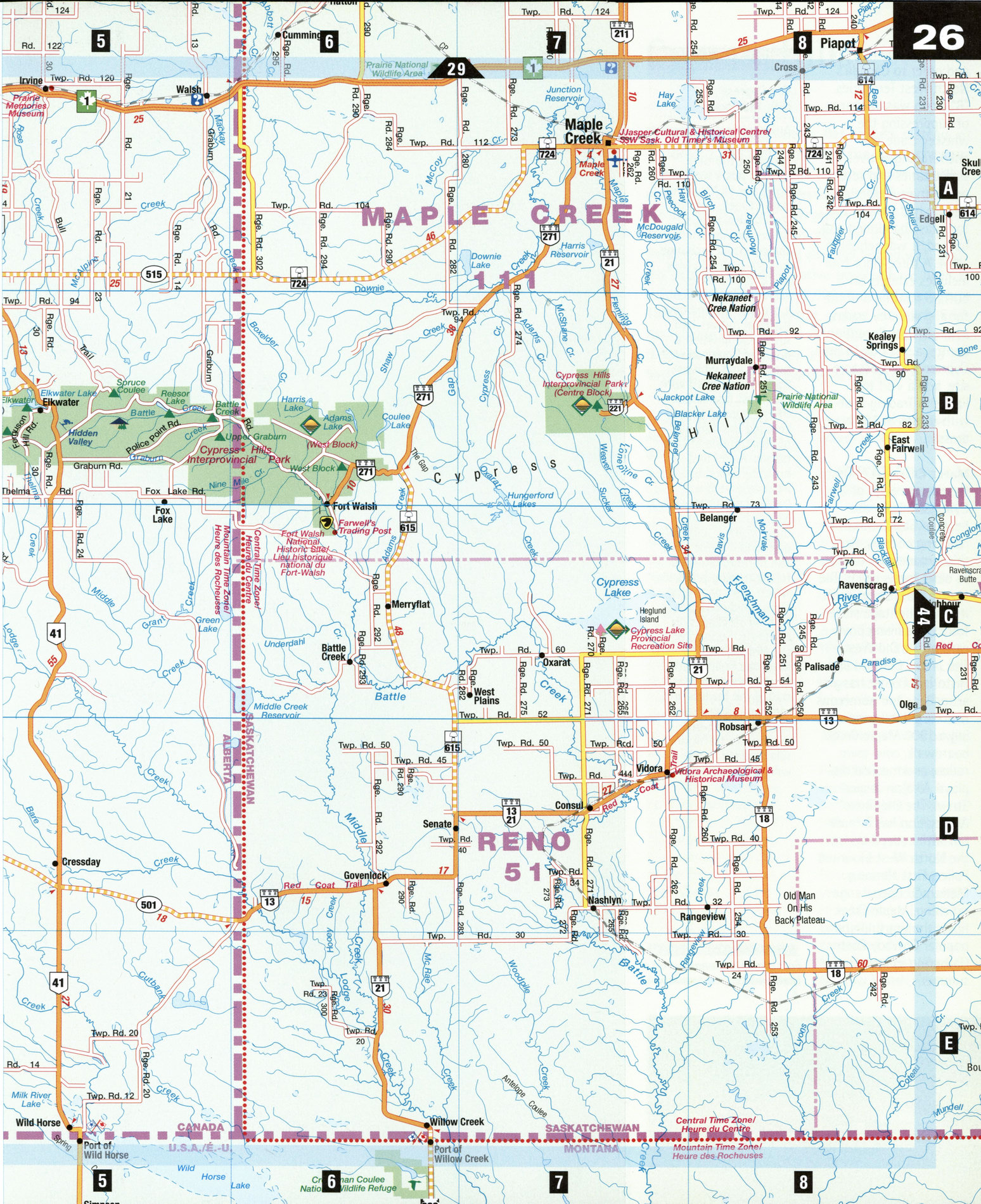Road map Maple Creek surrounding area (Alberta, Canada)
Road map of Maple Greek city area and Bow Island city area
Map of Cypress Hills. Detailed map of the highway and local roads of Cypress Hills with cities and towns.


Free map of Maple Greek city area and Bow Island city area (Canada)
Map of Cypress Hills. Detailed map of the highway and local roads of Cypress Hills with cities and towns.
Cypress Hills
The Cypress Hills are a flat-topped plateau of about 2,500 km2 straddling the Saskatchewan-Alberta border, a lofty oasis wafting with the smell of pine amidst the native fescue (shortgrass), unusual on the Prairies. Here evergreen forests, blue lakes, and marshes mark a sharp contrast to gently rolling fields covered in growing crops or dotted with grazing cattle and horses. Native peoples have been in this region for more than 7,000 years. Before the late 1800s, five different native groups, including Cree, Assiniboine, and Blood, hunted these hills. The area is steeped in the history of their fur trade and the battle to bring law and order to the frontier.
Cypress Hills Inter-provincial Park [B5-B6] Cypress Hills mark the highest point of Canadian land between the Rockies and Labrador. Straddling the Saskatchewan-Alberta border, this park features unusual glacial landforms such as knobs (rocks pushed into mounds) and kettles (depressions formed by melting ice), as well as flat-topped hills that rise as high as 1,468 m above the surrounding prairie. Wildlife, rare wildflowers, and lodge-pole pine cover the hills. There is evidence here that settlement stretches back millennia-stone and bone tools and other artifacts of the Besant, Pelican Lake, Oxbow, and Bit-terroot cultures found here were among the oldest in North America.
Etzicom [C2] The Etzicom Museum preserves local heritage in hands-on displays of pioneer life at a general store, hotel, school, blacksmith shop, post office, and barber shop. Adjacent to the museum is the Canadian National Historic Windmill Interpretive Centre. Here, the largest collection of windmills in Canada in a parklike setting covers 200 years of wind power.
Fort Walsh National Historic Site [C6] A part of Cypress Hills Park, this Saskatchewan site is a legacy of the North West Mounted Police era. Built two years after the Cypress Hills Massacre (see Local Lore, right) under the command of Superintendent James Morrow Walsh, Fort Walsh was to bring law and order to Canada's North West Territories. "B" troop was in charge of suppressing the whiskey trade and encouraging natives to sign treaties and settle on reserves. Before a decade had passed, the fort was abandoned and burned. It was rebuilt in 1944. A three-hour tour includes exhibits on buffalo hunting and the fur and whiskey trades at the Visitor Reception Centre, a bus ride to the Cypress Hills Massacre site, and a visit to Farwell's Trading Post with guides in 1870s dress.
Maple Creek [A7] On the eastern edge of the Cypress Hills, in the heart of Saskatchewan ranching country, lies this vintage cow town, as older locals call it. The town's main street, with its many heritage storefronts, is a living postcard of the Old West. The Jasper Cultural and Historical Centre has an art gallery and numerous historic exhibits, including a 1900 Maple Creek boardwalk, cow-town rodeo, and medical displays. Also on Jasper Street, The Oldtimers' Association has a museum with collections on the North West Mounted Police, First Nations, Metis, and open-range ranching. Maple Creek hosts the unusual and popular Cowboy Poetry Gathering in late summer.
LOCAL LORE
The Cypress Hills Massacre Although it was illegal to sell liquor to native people at the time, trading posts were set up in the 1870s along Battle Creek, deep in the Cypress Hills, so white and native traders could exchange furs for liquor. In May of 1873, near Abe Farwell's Trading Post, a group of Assiniboine (Lakoda) natives had set up camp when a group of American wolf hunters and whiskey traders-equipped with the latest fast-action rifles-stopped by and accused the natives of stealing one of their horses. Anger and hostility fueled by alcohol ignited a battle that ended with 31 dead: 30 Lakoda men, women, and children and 1 white man. The hunters returned to the trading posts, which were protected from rowdy customers by long stockades, to celebrate. Soon after, the North West Mounted Police were established to help curtail the lawless and rampant liquor trading, horse thieving, and border trafficking taking place in the wild West.